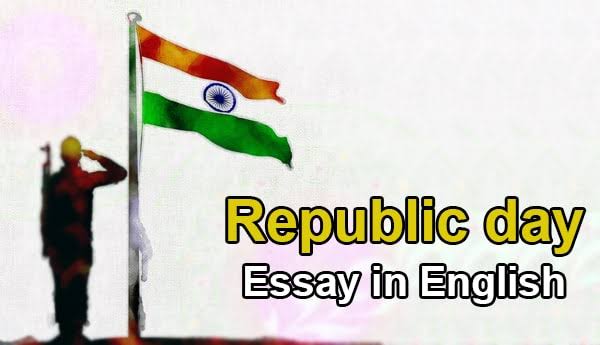Long Essay on Republic Day | 1000- 1500 Words
Introduction
26th January 1950 is a red-letter day in Indian history. On this day, India became the Sovereign Democratic Republic. Since then, 26th January is celebrated as our Republic Day every year all over India.
Sovereign means a country that is not only internally supreme but also independent of any external control. Democracy is a government of the people, by the people and for the people. In a Republic, the Head of State is not hereditary.
The people of their representatives elect him.
There is another reason for the Importance of date 26th January. The Constitution of India was promulgated on this day. The constitution was ready on 26th November 1949, but its promulgation was deferred to coincide with 26th January 1950.
On 26th January 1930, The all India Congress Committee at its Lahore Session held under the presidentship of Lt. Pt. Jawahar Lal Nehru pledged that India’s aim was “Purna Swaraj” that is complete independence from British rule.
Republic day reminds us of the sacrifices made by many brave-hearted Indians to realize their pledge of complete independence from British rule.
This day is celebrated throughout the country with great enthusiasm.
Being our national festival, every school, college, office, shop, factories, and other business establishments remain closed on this day due to the celebration of Republic Day. It is treated as a National Holiday.
Why We Celebrate Republic Day? – The History Behind Republic Day
The main reason of celebrating Republic Day is that on this day the constitution of our country came into the first effect.
However, there is another history of the great day, which is quite impressive. It started in December 1929 under the presidentship of Pandit Nehru at the Indian National Congress convention held in Lahore.
In which the congress announced that if India were not given Domination still until January 26, 1930, India would declare itself completely Independent, but when this day came. The British government did not respond to this issue.
Then, congress started its active movement from that day to achieve complete freedom. This is the reason that when our country was liberated, on January 26, on that day the constitution of India was established.
National Republic Day of India and Celebrations on Republic Day
As if we see Republic Day is not the day of celebration. It was the day when India attained full independence, even though India became independent on 15 August 1947. Still, it became utterly separate on 26 January 1950 “India Government Act” was withdrawn Day, the newly constituted Constitution of India was implemented.
Therefore, on that day, on January 26, it was celebrated as Republic Day for India. It is one of the National Festival among three. And apart from this, the other two are ‘Gandhi Jayanti’ and ‘Independence Day.’
Although Republic Day celebrations are held across the country, the major festivals are visible at Rajpath in New Delhi, with the President, the Prime Minister and other ministers in attendance.
The Republic Day march in Delhi is the most significant and most imperative of the processions denoting the Republic Day festivities in India. Indian Republic Days’ fascination keeps going for three days. The motorcade exhibits India’s protection ability and social and social legacy.
Republic Day Celebrations
Today, people across the country celebrate Republic Day with much zeal, fervour, and great excitement, especially in the capital, New Delhi. The ceremony commences with the President’s speech to the nation. He unfurls the National Flag as the National Anthem is played and twenty-one gun salutes are given. The President gives away the medals of bravery like Ashok Chakra and Kirti Chakra to the people from the armed forces for their exceptional courage in the field and also to the civilians, who have distinguished themselves by their exclusive acts of valour in various situations. The Prime Minister honours the sacrifice of the martyrs who sacrificed their lives for the country by laying a floral wreath at the Amar Jawan Jyoti, a memorial to all the brave soldiers at the India Gate, followed by two minutes of silence in the memory of the sacrifice of the soldiers. Every year a grand parade is held in the capital, Delhi, from the Rajghat, along the Vijaypath to mark the importance of this occasion. The various regiments of the Indian Army, the Indian Navy, and the Indian Air force perform their drill in all their regalia and official trinkets. The President of India, who is the Commander-in-Chief of the Indian Armed Forces, takes the salutation. Even the horses of the cavalry are attractively ornamented for the occasion. It is followed by a breathtaking fly-past in the sky by the Indian Air Force pilots making the parade more fascinating. The N.C.C cadets selected from all over the country consider it an honour to participate in this event. Several school children from various schools in the capital perform various dance forms in the parade. They spend many days preparing for the event.The parade is followed by a pageant of spectacular displays from different states of the country. Each display of jhankis, folk dances bring out the diversity and richness of the culture of India and the whole show lends a festive air to the occasion. Another important aspect of the Republic Day celebration is the presence of a chief guest. Since 1950, India has been inviting the head of state of another country as the guest of honour. The guest is chosen after deliberation on strategic, economic, and political interests. The parade and the ensuing pageantry are telecast on the National Television and are watched by millions of viewers in every corner of the country. The Beating Retreat Ceremony officially marks the end of Republic Day festivities and it is conducted on 29th January, the third day after the Republic Day parade. The bands of the three wings of the military: the Indian Army, Indian Navy, and Indian Air Force perform the ritual.
Significance of Aman Jawan Jyoti on Republic Day
Preceding the beginning of the Parade, the Prime Minister lays a botanical wreath at the Amar Jawan Jyoti, a remembrance to the fallen fighter at the India Gate towards one side of Rajpath, which is trailed by two minutes silence in the memory of fallen warriors.
The sacrifice of martyrs who lived for their country is remembered on this day.
From that point, the Prime Minister arrives at the central dais at Rajpath to join different dignitaries. Subsequently, the president, along with the chief guests, duly escorted by the President’s bodyguard on horseback, arrives to join others at Rajpath.
The National Flag is unfurled by the president by the president, after which the National Anthem is played along with a 21-gun salute.
Bravery Awards
Next, essential honors like the Ashok Chakra and Kirti Chakra are given away by the President before the regiments of Armed Forces begin their walk past.
The President presents awards of bravery to the members of the armed forces to their extraordinary mettle in the field and the civilians, who have farmed themselves by their distinctive demonstrations of courage in various circumstances.
Youngsters who get the National Bravery Award are observed riding on vividly or specially designed elephants or vehicles.
Parade, The Flypast, and The Daredevil Motorcade
For the event, the best NCC cadets are being chosen from all over the country think of it as respect to taking part in this occasion, as do the school youngsters from different schools in the capital.
Each Presentation exerts the decent variety and wealth of the way of life of India, and the entire show provides a bubbly air to the occasion. Around 1200 school children present dances and other cultural activities as a feature of the parade.
Then comes the Motorcade, this thrilling event took the last entry in the parade wit thrill-seeker engine cycle riding show by bike units of the Armed Forces and civil security services along with a flypast by the Indian Air Force planes and helicopters conveying the national banner and the banners of the armed forces.
Conclusion
Republic Day is one of the three national festivals of our country, and it is the day that reminds us of the importance of our Republic. It is a Gazetted Public Holiday in India, and people all over India celebrate the republic day with a great spirit of patriotism and joy.









.jpeg)
0 Comments